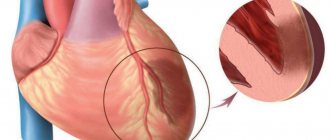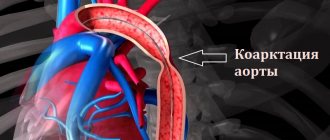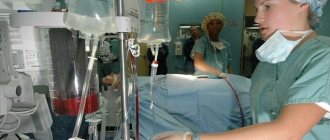Kidney failure
Pyelonephritis
Diabetes
5498 07 October
IMPORTANT!
The information in this section cannot be used for self-diagnosis and self-treatment.
In case of pain or other exacerbation of the disease, diagnostic tests should be prescribed only by the attending physician. To make a diagnosis and properly prescribe treatment, you should contact your doctor. Kidney failure: causes, symptoms, diagnosis and treatment methods.
Definition
Kidney failure is a condition in which one or both kidneys cannot fully perform their functions. This occurs as a result of some disease when the kidneys stop fully filtering the blood. Substances that should be eliminated from the body end up back into the bloodstream. Impaired kidney function may be associated with a decrease in blood flow through them and a sharp decrease in oxygen supply.
The main function of the kidneys is excretory, that is, cleansing the body of waste and toxins, while the kidneys are responsible for maximum preservation of nutrients.
The kidneys take part in phosphorus-calcium metabolism and the formation of bone tissue by producing calcitriol (the active form of vitamin D), so in children, kidney failure negatively affects bone growth and abnormal development, and in adults it can cause fragility.
The kidneys regulate blood pressure, so kidney failure causes it to rise.
The kidneys are involved in the formation of red blood cells - erythrocytes. With kidney failure, the number of red blood cells decreases and anemia develops.
The kidneys regulate the amount of water and salts - maintaining the water-salt balance.
Causes of kidney failure
There are many reasons for the development of kidney failure. Some lead to a rapid deterioration of kidney function, most often of ischemic or toxic origin (acute kidney injury, or acute renal failure). Others lead to a gradual deterioration of kidney function (chronic kidney disease, or chronic renal failure). In addition to the inability of the kidney tissue to filter the body's metabolic waste products (particularly creatinine and urea nitrogen) from the blood, the kidneys' ability to control the amount and distribution of water in the body (fluid balance) and the level of electrolytes in the blood is reduced. Acute kidney injury is a sudden decline in kidney function over several days or weeks, causing a buildup of nitrogenous compounds in the blood (azotemia). Causes of renal failure in the acute form of the disease:
- acute disturbances of renal hemodynamics (collapse, shock);
- intoxications of various origins (medicinal, insect and snake bites, household poisons);
- acute infectious kidney damage;
- acute inflammatory kidney diseases (pyelonephritis, acute glomerulonephritis);
- injury to the kidney or other organ with large blood loss;
- urinary tract obstruction;
- kidney removal.
Among all the causes of chronic renal failure, a special place is occupied by diseases that affect the renal glomeruli:
- renal diseases - chronic pyelonephritis and glomerulonephritis;
- metabolic diseases: amyloidosis, gout, diabetes;
- congenital renal diseases: narrowing of the renal arteries, underdevelopment of the kidneys, polycystic disease;
- rheumatic diseases: hemorrhagic vasculitis, scleroderma, systemic lupus erythematosus;
- serious disorders of the cardiovascular system: arterial hypertension and diseases leading to significant changes in renal blood flow (heart failure, arrhythmia);
- diseases that cause problems with the outflow of urine.
Acute renal failure is always a consequence of other pathological processes in the body.
If you immediately pay attention to its symptoms and take action, it is possible to completely restore the function of the affected kidney. In chronic renal failure, the kidneys are damaged irreversibly. In some cases, kidney failure in women can develop during pregnancy.
Although decline in kidney function is possible at any age, chronic kidney failure and acute kidney injury are more common in older adults. Many diseases that cause deterioration of kidney function can be treated to restore kidney function. Thanks to the availability of dialysis and kidney transplantation, kidney failure has become a manageable disease rather than a fatal one.
Classification of the disease
The International Classification of Diseases (ICD) 10 has been amended to replace the outdated term “chronic renal failure” with the term “chronic kidney disease” (code N18).
Modern classification is based on two indicators - glomerular filtration rate and signs of renal damage (proteinuria, albuminuria). Depending on their combination, there are five stages of chronic kidney disease.
The immediate causes of acute renal failure (code N17) are low blood flow velocity, acute destruction of the glomerulus with loss of afferent and efferent arteries and glomerular capillaries, damage to nephron tubules, or impaired outflow of urine from the kidney due to obstruction. Depending on this, there are three forms of acute renal failure:
- prerenal (70%),
- parenchymal (25%),
- obstructive (5%).
Symptoms of kidney failure
Kidney failure has the following main symptoms:
- decreased amount of urine excreted, urination disorder (oliguria, dysuria);
- swelling;
- general lethargy, drowsiness;
- nausea, vomiting, loss of appetite;
- tachycardia, increased blood pressure;
- bloating, loose stools.
Since in renal failure the kidneys do not perform their main - excretory - function, metabolism is disrupted.
Often the dominant symptoms of acute renal failure are manifestations of the underlying disease or symptoms caused by surgical complications of an operation that led to impaired renal function.
Chronic renal failure is characterized by an asymptomatic onset of the disease. At this stage, patients often do not complain; in extreme cases, they report increased fatigue with moderate physical activity, as well as dry mouth and weakness, which manifests itself in the late afternoon. Further attention is drawn to pale skin and flabby muscles that lose tone. Based on the results of a biochemical blood test, patients are often informed about the presence of protein in the urine and minor changes in the electrolyte composition of the blood.
The severity of symptoms depends on the stage of chronic kidney disease. The disease has an undulating course: the patient’s condition either improves or worsens again.
The terminal stage of chronic kidney disease is extremely dangerous, when the patient’s emotional reactions are disrupted (apathy sharply turns into excitement, night sleep is disturbed, and signs of lethargy appear). There is an ammonia odor from the mouth, swelling, the face becomes puffy, yellowish in color, traces of scratching are visible on the skin, the hair becomes dull, brittle, and dystrophy increases. Symptoms of uremic intoxication increase: ascites, pleurisy, pericarditis, uremic coma. Severe arterial hypertension often occurs.
Diagnosis of kidney failure
To diagnose renal failure, the following examinations are prescribed:
- general (clinical) blood test;
Spontaneous kidney rupture
Ultrasound scanner HS70
Accurate and confident diagnosis.
Multifunctional ultrasound system for conducting studies with expert diagnostic accuracy.
Introduction
Non-traumatic renal rupture, in other words, spontaneous renal rupture, unlike traumatic ruptures, is much less common and in many cases presents diagnostic difficulties [1-3]. In the world literature over the past century and a half since spontaneous renal rupture was identified as an independent pathology, over 1000 observations of spontaneous renal rupture have been published. However, a relatively small number of studies are devoted to studying the mechanisms of occurrence, diagnosis and treatment of spontaneous renal rupture. The main reason for this situation is the rarity of this pathology. Spontaneous renal rupture can be a complication of renal neoplasms, hydronephrosis, renal cysts, observed in periarteritis nodosa, acute pyelonephritis, urolithiasis, aneurysm of the renal arteries, Wegener's granulomatosis, renal infarction, hemorrhagic fever with renal syndrome, etc. Spontaneous kidney rupture may occur in a number of predisposing conditions, such as pregnancy and childbirth. In rare cases, spontaneous renal rupture may occur in an otherwise intact kidney. In turn, spontaneous renal rupture is part of a much larger family of pathological conditions, united in domestic and foreign literature under the general name “spontaneous perirenal bleeding.” Spontaneous perirenal bleeding can also be caused by blood diseases (leukemia, hemophilia, etc.), taking anticoagulants, adrenal rupture, adrenal tumors, aortic aneurysms, etc. [4].
Reviews summarizing cases described in the literature from 1933 to 2002 [5-8] included 448 observation units. The main etiological causes of spontaneous perirenal bleeding are tumors, which, according to various authors, occur with a frequency of 57 to 63% (of which 24-33% are benign and 30-33% are malignant). With a slightly lower frequency of occurrence, the causes of spontaneous renal rupture are vascular diseases (17-26%, of which periarteritis nodosa - 12-13%). The third main cause is infections (4-10%).
Currently, there is no uniform diagnostic and treatment strategy for determining spontaneous renal rupture, the severity and prognosis of this condition, despite the fact that spontaneous renal rupture is an urgent condition and requires immediate action. There are frequent cases of incorrect diagnosis, post-mortem diagnosis of spontaneous renal rupture, and unjustified delay of surgical intervention. At the same time, the increasing sensitivity of diagnostic methods such as ultrasound scanning, multislice computed tomography and magnetic resonance imaging significantly increases the surgeon’s ability to timely and accurately determine the cause of spontaneous renal rupture. Based on these data, in most cases it is possible to identify the cause that caused the kidney rupture, assess the feasibility of surgical intervention, and also plan its volume. We present our own observation when, on the basis of a comprehensive examination, we were able to establish a diagnosis of spontaneous renal rupture and choose a rational treatment tactic.
Clinical observation
The patient, 46 years old, was admitted to the Urological Clinic of the MMA named after. THEM. Sechenov with complaints of weakness, lethargy, fatigue, pain in the lumbar region on the right, palpable formation in the right half of the abdomen.
From the anamnesis it is known that 20 days ago a sharp pain suddenly arose in the lumbar region and lateral abdomen on the right, a rise in body temperature to subfebrile levels, 5 days ago total painless macrohematuria with shapeless clots appeared. It should be noted that the history did not contain direct or indirect indications of previous trauma, previous physical activity, or any surgical interventions. The patient was consulted at our clinic and hospitalized for surgical treatment.
Upon admission, the patient’s condition was satisfactory, the skin was pale and slightly moist. Body temperature has been normal for the last 4 days. In the right hypochondrium, a soft-elastic space-occupying formation up to 110 mm in size, motionless, is palpated. Blood tests showed a decrease in hemoglobin to 9.3 g/l. In urine tests, red blood cells cover the entire field of view. The blood pressure figures correspond to the usual ones (120/80 mm Hg), pulse 80 beats/min. According to the patient, hemodynamic parameters remained stable since the onset of clinical manifestations.
An ultrasound examination in the projection of the middle and lower segments of the right kidney reveals a hyperechoic formation up to 9 cm in diameter, with a clear contour, the integrity of which is compromised. In the perinephric tissue around the tumor there is an accumulation of anechoic fluid in the form of a hematoma (Fig. 1). The left kidney is without pathological changes. Conclusion: The ultrasound picture most likely corresponds to spontaneous rupture of an angiomyolipoma of the right kidney.
Rice. 1.
Ultrasonogram of the right kidney: A - anechoic fluid; B - hyperechoic formation.
Multislice computed tomography revealed that the right kidney was displaced anteriorly and medially by the hematoma. In the middle and lower segments of the kidney, a volumetric formation measuring 69x82x89 mm with tuberous contours, a heterogeneous structure, and areas of fat density predominate. Against the background of adipose tissue, areas of stroma are determined. In the upper sections, a zone of high density (up to 73 units) with uneven contours measuring 50x48 mm is a hematoma. The formation capsule is not clearly visible in several places (rupture?). With contrast enhancement, small vessels are identified in the peripheral regions. Areas of the stroma in the lower parts of the tumor accumulate the contrast agent. The perinephric tissue is tractable; it contains multiple areas of compaction, limited accumulations of fluid, and zones of high density (from 54 to 70 HU). With contrast enhancement, the density of these areas does not change. Streaks extend upward to the lower edge of the liver, downward along the psoas muscle to the level of the iliac vessels. It was concluded that the CT picture (Fig. 2 a-d) corresponds to an angiomyolipoma with hemorrhage into the neoplasm and perinephric tissue.
Rice. 2.
A series of computed tomograms.
a-d)
Angiomyolipomas (arrows - hemorrhage).
After performing multislice computed tomography (MSCT), it was confirmed that the clinical picture was caused by spontaneous rupture, most likely of an angiomyolipoma of the right kidney with hemorrhage into the neoplasm tissue and perinephric fat with the formation of a hematoma. It is necessary to determine the duration of the hemorrhage - whether there are areas of fresh hemorrhages against the background of bleeding into the perinephric tissue, which can determine the indications for emergency surgery. On MRI of the kidneys, the right kidney is displaced and rotated anteriorly (adjacent to the anterior abdominal wall). In its middle and lower segments, a space-occupying formation measuring 90x60x75 mm is detected, with a heterogeneous MR signal (characteristic of adipose tissue, blood in the subacute stage). The MR signal from the perirenal tissue is sharply inhomogeneously changed due to the presence of areas with a signal characteristic of blood in the subacute stage, edematous tissue with a total size of up to 90x75x110 mm. It appears that the renal capsule is ruptured. The MR picture corresponds to a space-occupying formation, most likely an angiomyolipoma, of the right kidney with hemorrhage (in the subacute stage) into the formation and perinephric tissue (Fig. 3).
Rice. 3.
MR tomogram (T2-VI). Tumor of the lower segment with decay and hemorrhage in the subacute stage (arrow).
The data obtained made it possible to exclude the presence of fresh ruptures and hemorrhages and to refuse emergency surgery, which is advisable given the low hemoglobin level in the patient and the planning of organ-preserving surgery. Indications for the latter are due to the presumably benign structure of the tumor, the young age of the patient, as well as her urgent desire to preserve the kidney. Taking into account the large size of the neoplasm and the presence of a hematoma in the perinephric tissue extending to the iliac vessels, the possibility of nephrectomy cannot be ruled out, which is permissible since the function of the opposite kidney is preserved. After 3 days, during which blood and its components were transfused (hemoglobin level was 13 g/l), an organ-preserving operation was performed, the possibility of which was finally established intraoperatively (Fig. 4 a-d).
Rice. 4.
Intraoperative picture of organ-preserving surgery.
a-d)
Stages of the operation.
This observation once again confirms that the size of the tumor does not always determine the possibility or impossibility of performing organ-conserving surgery, since when studying the gross specimen, the diameter of the tumor was 100 mm (Fig. 5).
Rice. 5.
Macroscopic specimen of a kidney tumor.
A)
Macroscopic specimen of a tumor of the right kidney in a block with perinephric tissue and hematoma, with a fragment of renal parenchyma, measuring 100×60 mm.
b)
On the section, the tumor is yellow-brown in color with whitish septa.
A morphological study confirmed that the removed tumor was an angiomyolipoma (Fig. 6).
Rice. 6.
Microscopic specimen of a tumor of the right kidney. Angiomyolipoma. Hematoxylin and eosin staining x 100
Six months after surgical treatment, the patient underwent multislice computed tomography. No pathological changes were detected. Resection area, perinephric tissue without features (Fig. 7).
Rice. 7.
A series of computed tomograms.
a, b)
6 months after surgery.
Discussion
Before the introduction of ultrasound diagnostic methods, approximately 25% of cases of renal angiomyolipoma presented with a sudden onset of pain in the flank or abdomen after spontaneous rupture and subsequent perirenal bleeding. Currently, criteria for ultrasound diagnosis of angiomyolipoma before the occurrence of complications and accompanying clinical symptoms have been developed. The echogenicity of angiomyolipoma on ultrasound depends on the relative content of fat masses in the tumor. Typical angiomyolipoma presents as masses that are hyperechoic compared with the rest of the renal parenchyma; in some cases, there may be an acoustic shadow or, in addition to this, a hypoechoic rim (subcapsular hematoma).
For correct and timely diagnosis of spontaneous kidney rupture or the disease that caused it, the use of modern research methods, such as ultrasound, MSCT, and MRI is required. First of all, screening methods are prescribed - ultrasound diagnostics, which allows you to quickly and confidently diagnose spontaneous renal rupture and carry out rational treatment tactics. Identification of fatty elements in the kidney parenchyma using MSCT in most cases suggests a diagnosis of angiomyolipoma, which should guide organ-preserving treatment tactics. Using MRI, it is possible to determine the age of hemorrhage and identify areas of fresh hemorrhage against the background of existing bleeding into the perinephric tissue, which can determine indications for emergency surgery.
Literature
- Shaw RE Spontaneous rupture of the kidney - Br. J. Surg. - 1957. - Vol. 45, p. 68-72.
- Henline RB Spontaneous rupture of kidney - J. Am. Med. Ass 1924, Vol. 83, p. 1411.
- Renander A. Another case of spontaneous rupture of renal pelvis - Acta Radiol., 1941. - Vol. 22, p. 422.
- Daskalopulos G., Karyotis I., Heretis I., Anezinis P., Mavromandolakis E., Delakas D. Spontaneous perirenal hemorrhage: a 10-year experience at our institution - Int Urol Nephrol., 2004;36(1):15- 9.
- Polkey HJ, Vynalek WJ Spontaneous notraumatic perirenal and renal hematomas. An experimental and clinical study. Arch. Sur., 1933, 26:196-202.
- Cinman AC, Farrer J., Kaufman JJ Spontaneous perinephric hemorrhage in a 65-year-old man - J. Urol. - 1985. - Vol. 133, p. 829-832.
- McDougal WS, Kursh ED, Persky L. Spontaneous rupture of the kidney with perirenal hematoma - J. Urol. - 1975. - Vol. 114, p. 181-184.
- Zhang JQ, Fielding JR, Zou KH Etiology of spontaneous perirenal hemorrhage: a meta-analysis - J. Urol. - 2002. - Vol. 167, p. 1593-1596.
Ultrasound scanner HS70
Accurate and confident diagnosis.
Multifunctional ultrasound system for conducting studies with expert diagnostic accuracy.







